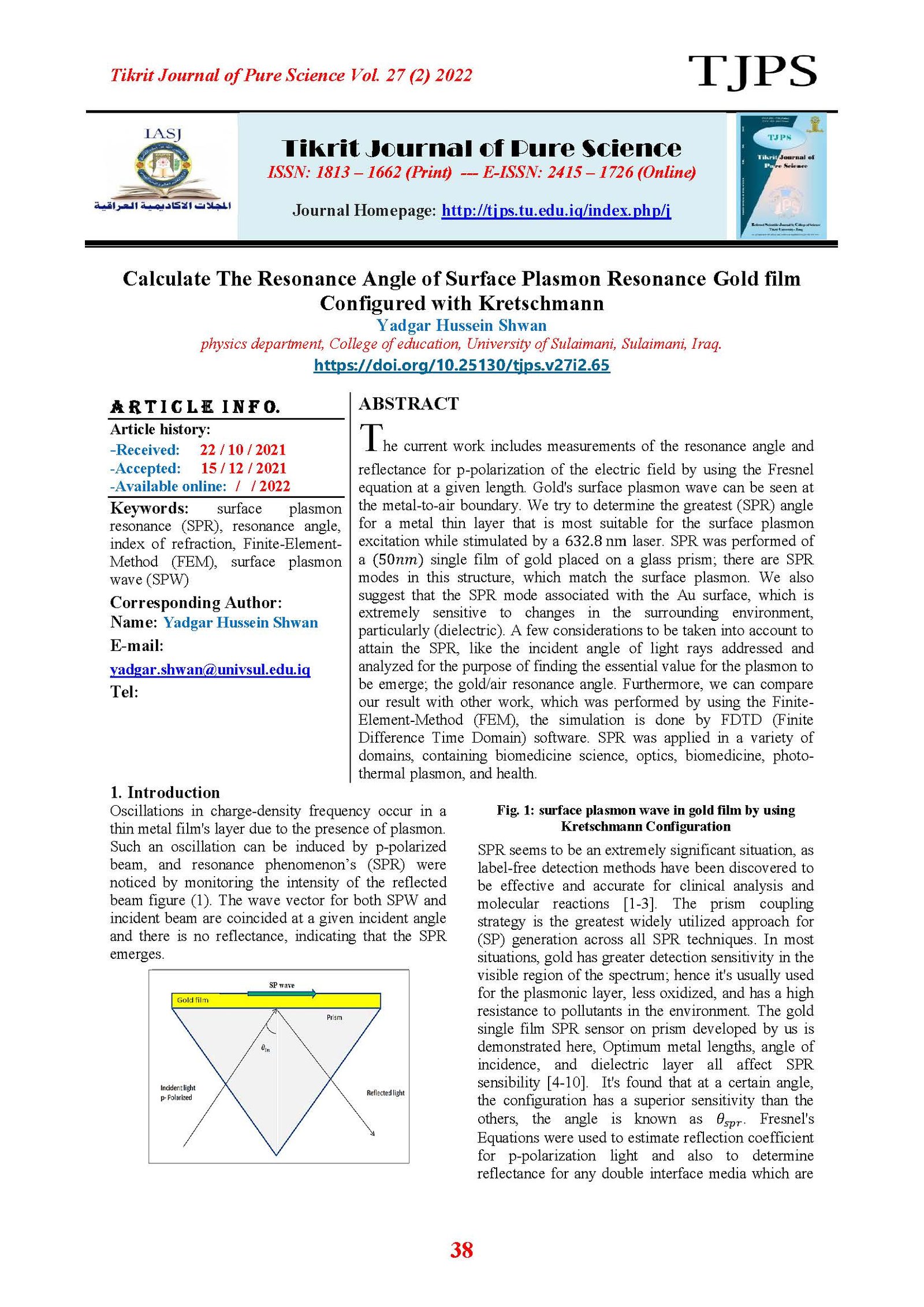Calculate The Resonance Angle of Surface Plasmon Resonance Gold film Configured with Kretschmann
Main Article Content
Abstract
The current work includes measurements of the resonance angle and reflectance for p-polarization of the electric field by using the Fresnel equation at a given length. Gold's surface plasmon wave can be seen at the metal-to-air boundary. We try to determine the greatest (SPR) angle for a metal thin layer that is most suitable for the surface plasmon excitation while stimulated by a laser. SPR was performed of a single film of gold placed on a glass prism; there are SPR modes in this structure, which match the surface plasmon. We also suggest that the SPR mode associated with the Au surface, which is extremely sensitive to changes in the surrounding environment, particularly (dielectric). A few considerations to be taken into account to attain the SPR, like the incident angle of light rays addressed and analyzed for the purpose of finding the essential value for the plasmon to be emerge; the gold/air resonance angle. Furthermore, we can compare our result with other work, which was performed by using the Finite-Element-Method (FEM), the simulation is done by FDTD (Finite Difference Time Domain) software. SPR was applied in a variety of domains, containing biomedicine science, optics, biomedicine, photo-thermal plasmon, and health.
Article Details

This work is licensed under a Creative Commons Attribution 4.0 International License.
Tikrit Journal of Pure Science is licensed under the Creative Commons Attribution 4.0 International License, which allows users to copy, create extracts, abstracts, and new works from the article, alter and revise the article, and make commercial use of the article (including reuse and/or resale of the article by commercial entities), provided the user gives appropriate credit (with a link to the formal publication through the relevant DOI), provides a link to the license, indicates if changes were made, and the licensor is not represented as endorsing the use made of the work. The authors hold the copyright for their published work on the Tikrit J. Pure Sci. website, while Tikrit J. Pure Sci. is responsible for appreciate citation of their work, which is released under CC-BY-4.0, enabling the unrestricted use, distribution, and reproduction of an article in any medium, provided that the original work is properly cited.
References
[1] Monzón-Hernández, D., Villatoro, J., Talavera, D., & Luna-Moreno, D. (2004). Optical-fiber surface-plasmon resonance sensor with multiple resonance peaks. Applied optics, 43(6), 1216-1220.
[2] Mohapatra, S., & Moirangthem, R. S. (2018, February). Theoretical study of modulated multi-layer SPR device for improved refractive index sensing. In IOP Conference Series: Materials Science and Engineering (Vol. 310, No. 1, p. 012017). IOP Publishing.
[3] Mohapatra, S., Kumari, S., & Moirangthem, R. S. (2017). Fabrication of a
cost-effective polymer nanograting as a disposable plasmonic biosensor using nanoimprint lithography. Materials Research Express, 4(7), 076202.
[4] Kumari, S., Mohapatra, S., & Moirangthem, R. S. (2017). Development of
flexible plasmonic plastic sensor using nanograting textured laminating film. Materials Research Express, 4(2), 025008.
[5] Chen, Y., Yu, Y., Li, X., Tan, Z., & Geng, Y. (2015). Experimental comparison of fiber-optic surface plasmon resonance sensors with multi metal layers and single silver or gold layer. Plasmonics, 10(6), 1801-1808.
[6] Fontana, E. (2006). Thickness optimization of metal films for the development of surface-plasmon-based sensors for nonabsorbing media. Applied optics, 45(29), 7632-7642.
[7] Ghorbanpour, M. (2013). Optimization of sensitivity and stability of
gold/silver bi-layer thin films used in surface plasmon resonance chips. Journal of Nanostructures, 3(3), 309-313.
[8] Srivastava, S. K., Verma, R., & Gupta, B. D. (2016). Theoretical modeling of
a self-referenced dual mode SPR sensor utilizing indium tin oxide film. Optics Communications, 369, 131-137.
[9] Tran, N. H. T., Phan, B. T., Yoon, W. J., Khym, S., & Ju, H. (2017). Dielectric
metal-based multilayers for surface plasmon resonance with enhanced quality factor of the plasmonic waves. Journal of Electronic Materials, 46(6), 3654-3659.
[10] Maharana, P. K., & Jha, R. (2012). Chalcogenide prism and graphene multilayer based surface plasmon resonance affinity biosensor for high performance. Sensors and Actuators B: Chemical, 169, 161-166.
[11] Mohapatra, S., & Moirangthem, R. S. (2018, February). Theoretical study of modulated multi-layer SPR device for improved refractive index sensing. In IOP Conference Series: Materials Science and Engineering (Vol. 310, No. 1, p. 012017). IOP Publishing. Mohapatra, S., & Moirangthem, R. S. (2018, February). Theoretical study of modulated multi-layer SPR device for improved refractive index sensing. In IOP Conference Series: Materials Science and Engineering (Vol. 310, No. 1, p. 012017). IOP Publishing.
[12] Abiyasa, A. P., Yu, S. F., Lau, S. P., Leong, E. S., & Yang, H. Y. (2007). Enhancement of ultraviolet lasing from Ag-coated highly disordered ZnO films by surface-plasmon resonance. Applied physics letters, 90(23), 231106.
[13] Leelawattananon, T., Lorchalearnrat, K., & Chittayasothorn, S. (2017, July). Simulation of Copper Thin Film Thickness Optimization for Surface Plasmon using the Finite Element Method. In SIMULTECH (pp. 188-195).
[14] Nguyen, D., & Voronine, D. (2020). Calculating Resonance Angle for Surface Plasmon Resonance Activation on Different Metals. Undergraduate Journal of Mathematical Modeling: One+ Two, 11(1), 8.
[15] Menon, P. S., Said, F. A., Mei, G. S., Berhanuddin, D. D., Umar, A. A., Shaari, S., & Majlis, B. Y. (2018). Urea and creatinine detection on nano-laminated gold thin film using Kretschmann-based surface plasmon resonance biosensor. PloS one, 13(7), e0201228.
